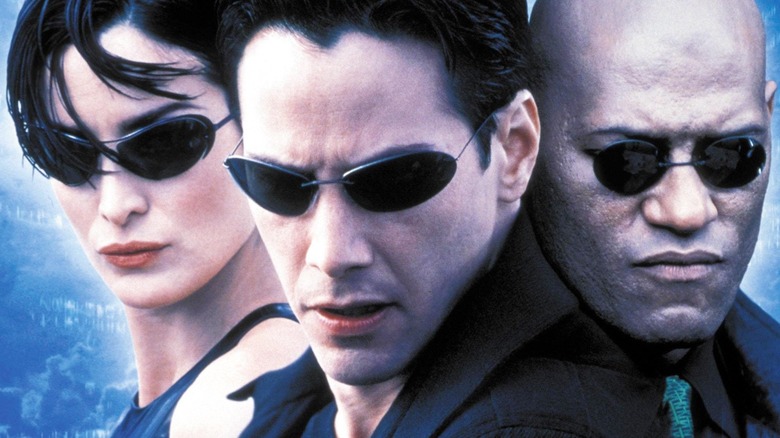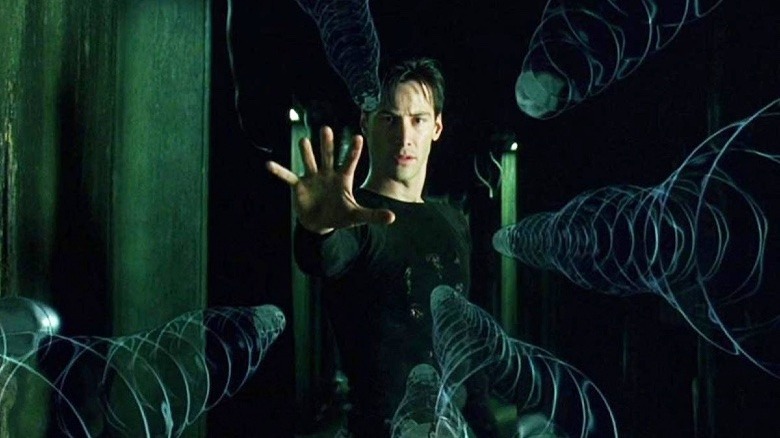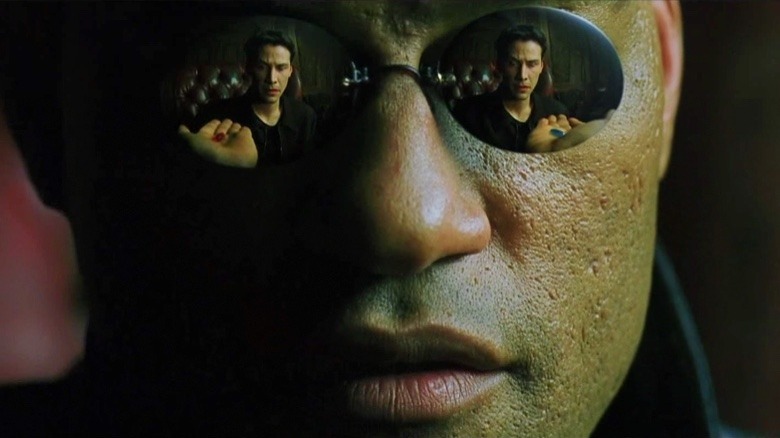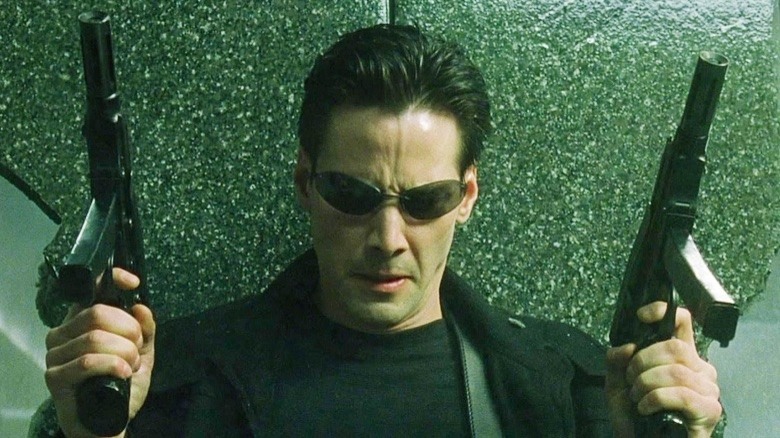The Matrix Ending Explained: Know Thy Self
"The Matrix" was a true sensation upon its release in 1999, with its heady mix of cyberpunk imagery, philosophizing, and "Bullet Time" action spawning countless parodies and imitators in the years after. It's also a perfect time capsule of the 1990s — from the way it embodies the decade's fears about the scary, wild digital frontier that is the Internet, to its fashion (fetishistic black leather outfits and trench coats FTW!), to a soundtrack fueled by the rebellious spirit of heavy metal (Rob Zombie), hard rock (Rage Against the Machine), and more.
Keanu Reeves stars in "The Matrix" as Neo (born Thomas Anderson), a hacker who learns that the world as he knows it is actually a simulated reality created by sentient machines to control humans while they harness their bodies for energy in the wake of a war that left Earth a scorched wasteland. Guiding Neo on his journey of self-discovery is the stoic Morpheus (Laurence Fishburne), a freed human who believes Neo is a being prophesied to bring about the end of the Matrix, and Trinity (Carrie-Anne Moss), a fierce leader among Morpheus' band of revolutionaries who is secretly in love with Neo.
However, the further down the rabbit hole you go, the clearer it becomes that Lana and Lilly Wachowski's iconic sci-fi thriller has even more on its mind than audiences realized when it first hit the scene.
The Ending of The Matrix
In time, Neo learns that Agents (sentient programs capable of superhuman feats) monitor the Matrix to stop people from escaping. One especially ruthless Agent, Smith (Hugo Weaving), is determined to find Morpheus, believing him the key to accessing the computer mainframe of the free humans' base, dubbed Zion. When his efforts to track Morpheus through Neo fail, Smith makes a deal with Cypher (Joe Pantoliano), a member of Morpheus' crew who yearns to forget the truth and return to the Matrix. Cypher's betrayal allows Smith to capture the elusive freedom fighter, and Morpheus' capture puts his allies in danger of getting caught themselves.
Neo, having grown convinced he's not "The One" as Morpheus believes, then spearheads a mission to rescue their comrade, knowing it could easily mean his death. And yet Neo manages to not just rescue Morpheus from Smith's clutches but even holds his own against the Agent in a fight ... at least, until Smith shoots him dead. Then, the unthinkable happens: Trinity tells Neo she loves him in the real world, and he re-awakens within the Matrix, suddenly able to stop bullets using his mind and battle Agents while (literally) keeping one hand behind his back. He is the One!
Audiences, suffice it to say, readily caught the nods to Jesus Christ and Christianity in "The Matrix" — be they characters' names, Cypher's role as the story's Judas, or, most pointedly, Neo's resurrection. Nobody missed the film's existentialist themes either, granted that nearly everyone in the movie explicitly discusses free will, choice, and purpose through their dialogue. But there's even more to the ending of "The Matrix" than that.
The Matrix As a Trans Allegory
What most didn't catch (at the time) is that "The Matrix" also serves as a potent allegory for being trans. As many have observed since the Wachowskis came out as transgender women after the movie's release, the red pill that Neo takes (allowing Morpheus to free him from the Matrix) recalls the red estrogen pills taken by trans women, while the montage of Neo's atrophied muscles being rebuilt later taps into the idea of physical transformation allowing someone to better realize their internal sense of who they are.
Further along those lines, Morpheus describing Neo's lifelong feeling that "there's something wrong with the world" acts as a metaphor for gender dysphoria, much like Smith's refusal to use Neo's chosen name (instead calling him "Mr. Anderson") suggests the act of dead-naming: an act where someone denies a trans or non-binary individual's gender identity by using their birth name or some other former name without their permission.
The Wachowskis have supported this reading of "The Matrix," with Lilly Wachowski stating the film is "all about the desire for transformation, but it was all coming from a closeted point of view." She also talked about how, in an earlier version of the movie's script, the character Switch (a member of Morpheus' team) was male in the real world and female in the Matrix, which would've made the trans subtext all the more explicit. It's no wonder Neo's own transformation ends up empowering him and setting him on the path to truly knowing who he is.
Woah — Does The Matrix Hold Up?
As with its '90s tech and culture, "The Matrix" used a lot of tropes that are now widely recognized as outdated and, at worst, regressive — like Neo being a white savior (which almost wasn't the case) or Gloria Foster's Oracle (the elderly prophet that assists the film's heroes) perpetuating the "magical negro" archetype. The movie's stance on digital technology is also very much of its time and, naturally, lacks the nuance and depth of more recent films that look at both the good and bad of a world where people live much of their lives online (or, as "The Matrix" put it, plugged in).
Of course, none of this takes away from the film's intense, gravity-defying fight choreography, nightmarish visuals, or greatest lines (all of which still firmly rock), much less the newfound layers of meaning people have found in its story over time. Moreover, for all their flaws, the sequels "The Matrix Reloaded" and "Revolutions" served to correct some of the first movie's biggest missteps, most notably by reframing Neo as one in a long line of "Chosen Ones" and the Oracle as a program with agency who seeks to bring about radical change from within The Matrix.
With Lana Wachowski directing December's "The Matrix Resurrections," the hope is the upcoming sequel will only further evolve the franchise's themes and mythology. (If nothing else, its visuals look spectacular.) Failing that, the original movie will continue to stand as a landmark achievement.



